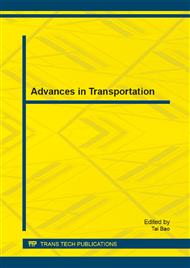p.1005
p.1014
p.1023
p.1028
p.1037
p.1041
p.1046
p.1055
p.1061
Pedestrian Evacuation with a Improved Dynamic Parameters Model
Abstract:
A improved dynamic parameters model is presented based on cellular automata in this paper.The dynamic parameters: Direction-parameter, Empty-parameter and Cognition-parameter are formulated to simplify tactically the decision-making process of pedestrians, which can reflect the pedestrian judgment on the surrounding conditions and decide the pedestrians choice of action. Simulation of pedestrian evacuation and pedestrian moving rules were established, according to two-dimensional cellular automaton Moore neighborhood. In the improved model, the impact of the pedestrian density around exits is considered, the simulation and experimental results prove that this improvement makes sense, because besides the spatial distance to exits, people may also choose the exit according to the pedestrian density around exits. And the simulation results of improved model is compared with experiment, comparison shows that the improved model can reproduce the experiment well. The improved model is useful for further study, it is instructional significant for pedestrian evacuation, avoiding or reducing the number injuries.
Info:
Periodical:
Pages:
1037-1040
Citation:
Online since:
January 2014
Authors:
Price:
Сopyright:
© 2014 Trans Tech Publications Ltd. All Rights Reserved
Share:
Citation:


